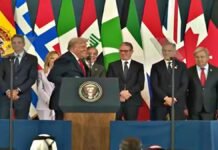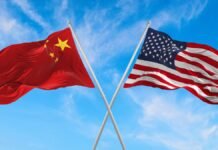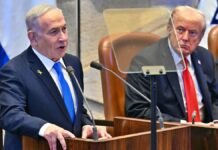
Key Points
- President Trump announced additional 100% tariff on all Chinese imports effective November 1, 2025, bringing total US tariffs on China to 130%
- China implementing two-phase export controls: November 8 restrictions on rare earths and critical materials, December 1 licensing requirements for heavy rare earths
- New Chinese restrictions target military equipment components including electric motors for missiles, fighter jets, and targeting systems
- China requires foreign companies to obtain licenses for products containing 0.1% or more Chinese-origin heavy rare earths starting December
- Export controls include five additional rare earth types, battery anodes, synthetic diamonds, and specialized equipment
- European defense industries face potential crisis as Ukraine and NATO allies rely on Chinese materials for military production
- China introduced new port fees for US vessels and launched antitrust investigation into Qualcomm on October 9[8]
- Current tariff truce set to expire November 10, 2025, potentially escalating to 145% US tariffs and 125% Chinese counter-tariffs
New Delhi: President Donald Trump’s escalating tariff war with China has reached a critical inflection point that threatens to disrupt global supply chains and economic stability worldwide, as Beijing announced sweeping export restrictions on critical materials and military components in retaliation for threatened 130% US tariffs on Chinese goods. The dramatic escalation, unfolding in October 2025, has positioned the world’s two largest economies on a collision course that analysts warn could reshape international trade relationships and severely impact European defense capabilities amid ongoing geopolitical tensions.
Trump’s 100% Tariff Threat Triggers Retaliation
On October 10, 2025, President Trump announced he would impose an additional 100% tariff on all Chinese imports effective November 1, 2025, or sooner if Beijing continues what he described as “aggressive” trade actions. This new tariff layer, added on top of the existing 30% duties already in place on Chinese goods, brings the total US tariff rate on Chinese imports to a staggering 130%, marking one of the most aggressive trade measures in modern history.
Speaking on Truth Social, Trump characterized China’s recent export restrictions as a “hostile act” requiring a strong response. “It has just been learned that China has taken an extraordinarily aggressive position on trade… effective November 1, 2025, they plan to impose large-scale export controls on virtually every product they make,” Trump wrote. He further described these actions as unprecedented in international trade, declaring them a “moral disgrace in dealing with other Nations”.
In addition to the tariffs, Trump announced plans to enforce export restrictions on “any and all critical software” beginning November 1, significantly broadening the scope of US trade restrictions beyond traditional goods to include technology and intellectual property. The announcement comes as both Trump and Chinese President Xi Jinping are expected to attend the upcoming Asia-Pacific Economic Cooperation (APEC) Summit in South Korea later this month, though Trump has previously threatened to cancel meetings with the Chinese leader.
China’s Two-Phase Export Control Strategy
China has responded with a comprehensive two-phase export control regime targeting critical materials and military equipment components that will fundamentally alter global supply chain dynamics. The first phase, set to begin on November 8, 2025, imposes restrictions on five additional types of rare earth elements, certain battery anodes, synthetic diamonds, and specialized manufacturing equipment.
Beginning in December 2025, the second phase requires foreign companies to obtain licenses from the Chinese government to export products containing 0.1 percent or more of Chinese-origin heavy rare earths or manufactured using Chinese technologies. This licensing requirement represents an extraordinary extension of Chinese regulatory authority over global manufacturing processes, as rare earth elements are essential components in countless modern technologies ranging from smartphones and electric vehicles to advanced military systems.
China’s Ministry of Commerce announced these measures citing national security concerns, defending the export restrictions as necessary responses to American actions including the addition of Chinese companies to trade blacklists and the imposition of new port fees on vessels linked to China. Chinese officials characterized Trump’s 100% tariff threat as hypocritical while defending their restrictions on rare earths and other critical materials.
Military and Defense Equipment Restrictions
Among the most significant aspects of China’s export controls are sweeping restrictions on military equipment components that will severely impact defense industries worldwide, particularly in Europe. The banned exports include powerful electric motors used in missiles and fighter jets, range-determining devices essential for tank operations, and precision targeting systems for various weapons platforms.
These restrictions come at a critical juncture for European defense planning, as NATO allies and Ukraine seek to strengthen military capabilities amid escalating tensions with Russia. European defense contractors have grown increasingly dependent on Chinese-manufactured components and materials due to their cost-effectiveness and technical specifications. The sudden cutoff of these supplies could create significant production bottlenecks and force European nations to rapidly develop alternative supply chains or domestic manufacturing capabilities at substantially higher costs.
Jay Truesdale, who served in the Obama administration, warned that “we are entering a new phase of economic tension” as these export controls fundamentally alter the calculus of international trade and security cooperation. The intertwining of trade policy with national security concerns means that traditional economic negotiations may no longer suffice to resolve these disputes, requiring new frameworks for managing interdependencies between major powers.
Rare Earth Monopoly and Strategic Leverage
China’s dominance in rare earth production and processing gives Beijing extraordinary leverage in this trade conflict, as these materials are irreplaceable in numerous high-tech applications. The country controls approximately 70-80% of global rare earth mining and over 90% of rare earth processing capacity, making it virtually impossible for other nations to quickly substitute alternative sources.
Previously, in April 2025, China banned the supply of rare earths and magnets manufactured from them, affecting production of electric vehicles, computer chips, and other devices worldwide, including India’s manufacturing sector. Those earlier restrictions demonstrated Beijing’s willingness to weaponize its rare earth monopoly, and the new October 2025 measures represent a significant escalation in scope and severity.
The December licensing requirements for products containing even trace amounts of Chinese-origin heavy rare earths effectively extend Chinese regulatory authority throughout global supply chains. Companies worldwide will need to track the origin of rare earth materials through multiple tiers of suppliers and obtain Chinese government approval to export finished products, creating enormous compliance burdens and potential chokepoints in international commerce.
Impact on Electric Vehicles and Technology Manufacturing
The export restrictions on battery anodes and rare earth materials will have profound implications for the global electric vehicle industry and broader technology manufacturing sectors. Battery anodes are critical components in lithium-ion batteries used in electric vehicles, smartphones, laptops, and energy storage systems. China’s control over battery material supply chains gives it the ability to significantly disrupt the electric vehicle transitions underway in Europe, North America, and other markets.
Synthetic diamonds, also included in the November 8 restrictions, are essential for precision cutting tools, high-performance semiconductors, and various industrial applications. The restriction on specialized manufacturing equipment could force technology companies to redesign production processes or invest billions in developing alternative tooling, causing significant delays in product development cycles and market introductions.
These measures build on earlier disruptions that affected computer chip production globally, as rare earth elements are essential for semiconductor manufacturing. The cumulative effect of multiple waves of Chinese export restrictions has created an environment of uncertainty that makes long-term business planning extremely difficult for technology companies operating in global markets.
European Vulnerability and Defense Crisis
European countries face the most severe consequences from China’s export restrictions, particularly regarding military equipment components. While the United States maintains more diverse supply chains and domestic production capabilities for many critical defense systems, European defense industries have become increasingly dependent on Chinese materials and components to maintain cost competitiveness.
The timing could not be worse for European military planning, as NATO allies work to strengthen deterrence against potential Russian aggression and support Ukraine’s ongoing defense needs. The restriction on electric motors for missiles and fighter jets, range-finding equipment for tanks, and precision targeting systems threatens to create immediate shortages in critical military hardware production lines.
China’s anger over European Union tariffs imposed on Chinese electric vehicles has contributed to Beijing’s willingness to use export controls as retaliation, even if doing so creates collateral economic damage. European policymakers now face difficult choices between maintaining economic relationships with China, supporting Ukraine and NATO defense requirements, and developing expensive domestic alternatives to Chinese-manufactured defense components.
Tariff Truce Expiration and Escalation Risk
The current situation unfolds against the backdrop of a fragile tariff truce between the United States and China that is set to expire on November 10, 2025. On August 11, 2025, President Trump signed an executive order extending the tariff truce by 90 days to prevent economic disruption during the critical holiday trade season.
Without the extension or a new agreement, US duties on Chinese goods could jump to 145 percent, while China’s retaliatory tariffs might rise to 125 percent, effectively approaching a trade embargo. The 90-day extension maintained US tariffs at 30 percent on Chinese imports and 10 percent on US goods exported to China, providing temporary relief for supply chain planning.
However, Trump’s October 10 announcement of additional 100% tariffs effective November 1 appears to supersede the tariff truce framework, potentially accelerating the escalation timeline. If both the November 1 tariffs and the November 10 tariff truce expiration proceed as announced, the combined effect could push US-China trade relationships to unprecedented levels of confrontation.
Additional Chinese Countermeasures
Beyond export restrictions, China has implemented several other measures targeting American economic interests. On October 9, 2025, the Chinese government introduced new port fees specifically targeting US vessels, adding costs to American shipping companies operating in Chinese waters. These fees represent a direct retaliation for US maritime policies and contribute to the broader economic pressure campaign.
Additionally, Chinese regulators initiated an antitrust investigation into Qualcomm, the American semiconductor and telecommunications equipment manufacturer, on October 9, 2025. This investigation signals Beijing’s willingness to use regulatory tools beyond trade policy to pressure American companies and create leverage in negotiations. Qualcomm’s significant business interests in China make it particularly vulnerable to regulatory scrutiny, potentially forcing the company to choose between complying with Chinese demands or facing market exclusion.
Mutual Dependencies and Structural Challenges
The escalating trade war highlights the fundamental challenge of mutual economic dependencies between the United States and China that make de-escalation difficult. As long as the United States relies on China’s rare earths, batteries, and manufacturing capacity, while China depends on American technology, semiconductors, and consumer markets, disentangling export controls from trade and national security concerns will prove exceedingly challenging.
As of Monday morning, October 13, Beijing has not formally retaliated against Trump’s 100% tariff threat beyond its existing export restrictions, suggesting that President Xi may not be inclined to escalate tensions further in the immediate term. However, with time remaining before the latest measures from both sides are enacted, it is unlikely that either country will significantly retract their export controls.
Analysts suggest that both nations may alternatively choose to delay implementation of certain aspects or issue one-year licenses to ensure a temporary period of stability. Such face-saving compromises could provide breathing room for negotiations while allowing both leaders to claim they stood firm against the other’s provocations.
Global Economic Implications
The International Monetary Fund has previously noted that US-China trade tensions could reduce global GDP by up to 1 percent, and the current escalation threatens even more severe economic consequences. The uncertainty created by rapidly changing tariff rates and export restrictions makes long-term business planning nearly impossible, forcing companies to maintain excess inventory, develop redundant supply chains, and pass increased costs to consumers.
For countries like India, the trade war creates both opportunities and challenges. Indian manufacturers could benefit from production shifting away from China, but they also face potential supply disruptions for critical materials and components needed for domestic industries. The April 2025 rare earth ban affected Indian manufacturing sectors, demonstrating the country’s vulnerability to Chinese export restrictions.
The escalating situation has prompted businesses worldwide to accelerate supply chain diversification efforts, exploring alternatives in Southeast Asia, India, Mexico, and other regions. However, replicating China’s manufacturing scale, efficiency, and rare earth processing capabilities will require years of investment and may never fully substitute for Chinese production in certain sectors.
Outlook and Negotiation Prospects
Both Washington and Beijing have emphasized the importance of maintaining economic stability, but the current trajectory suggests that rhetoric may not match actions. Analysts see the potential for a Trump-Xi summit later this year, possibly at the APEC meeting in South Korea, as laying groundwork for negotiations that could produce a more comprehensive trade agreement.
However, the fundamental differences in economic systems, national security priorities, and geopolitical ambitions make any lasting resolution extraordinarily difficult to achieve. Even if negotiators reach a temporary deal, the mutual dependencies and strategic competition mean that trade hostilities could flare again anytime circumstances change or domestic political considerations shift.
The coming weeks will be critical, as November 1 marks the implementation date for Trump’s additional 100% tariffs and export controls on critical software, November 8 brings the first phase of China’s expanded export restrictions, and November 10 represents the expiration of the current tariff truce. Whether the two sides can find an off-ramp from escalation or whether the trade war enters an even more destructive phase will have profound implications for the global economy and geopolitical order for years to come.






































